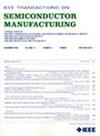利用整个光学发射光谱对等离子体蚀刻过程中的关键尺寸进行虚拟测量
IF 2.3
3区 工程技术
Q2 ENGINEERING, ELECTRICAL & ELECTRONIC
引用次数: 0
摘要
本文基于对光学发射光谱(OES)信号的所有时间和波长样本的分析,提出了等离子体蚀刻过程中虚拟计量(VM)的新方法。新方法将每个 OES 信号扁平化为单一向量,然后对训练数据集中扁平化 OES 信号向量形成的矩阵进行奇异值分解(SVD)。扁平化和标准化 OES 记录的低秩 SVD 投影可作为基于岭回归、人工神经网络和随机森林的 VM 模型的输入。随后,对从一家大型 300 毫米晶圆制造厂收集的数据集进行了虚拟机研究,结果表明,使用新提出的基于 SVD 的 OES 特征始终优于基准虚拟机模型特征。根据可分析的岭回归虚拟机模型形式对特征重要性进行的其他分析表明,OES 信号部分的独特时频模式对预测相关临界维度具有很高的参考价值,这清楚地证明了将整个 OES 信号用于虚拟机的必要性。本文章由计算机程序翻译,如有差异,请以英文原文为准。
Virtual Metrology of Critical Dimensions in Plasma Etch Processes Using Entire Optical Emission Spectrum
This paper proposes a novel method for Virtual Metrology (VM) in plasma etch processes based on analysis of all time and wavelength samples of Optical Emission Spectroscopy (OES) signals. The new method flattens each OES signal into a single vector, after which Singular Value Decomposition (SVD) is performed on the matrix formed by vectors of flattened OES signals in the training dataset. Low rank SVD projections of flattened and standardized OES recordings served as inputs for Ridge Regression, Artificial Neural Network, and Random Forest based VM models. A VM study is then conducted on a dataset gathered from a major 300 mm wafer fabrication facility, showing that the use of newly proposed SVD-based OES features consistently outperformed benchmark VM model features. Additional analysis of feature importance performed based on the analytically tractable Ridge Regression VM model form demonstrated distinct time-frequency patterns of OES signal portions that were highly informative for prediction of relevant Critical Dimensions, clearly justifying the need to use the entire OES signals for VM.
求助全文
通过发布文献求助,成功后即可免费获取论文全文。
去求助
来源期刊

IEEE Transactions on Semiconductor Manufacturing
工程技术-工程:电子与电气
CiteScore
5.20
自引率
11.10%
发文量
101
审稿时长
3.3 months
期刊介绍:
The IEEE Transactions on Semiconductor Manufacturing addresses the challenging problems of manufacturing complex microelectronic components, especially very large scale integrated circuits (VLSI). Manufacturing these products requires precision micropatterning, precise control of materials properties, ultraclean work environments, and complex interactions of chemical, physical, electrical and mechanical processes.
 求助内容:
求助内容: 应助结果提醒方式:
应助结果提醒方式:


